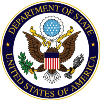Good Arctic Science Informs Good Arctic Policy
By: U.S. Special Representative for the Arctic Robert J. Papp, Jr.
Earlier this month, Secretary Kerry and I visited Norway and Denmark to see firsthand the climate-change effects occurring in the Arctic and to meet with the scholars undertaking cutting-edge research on the dramatic environmental shifts occurring in the region. What we saw was alarming: glaciers that have been frozen for millennia are now calving into the ocean, and sea ice, a vital habitat for marine mammals and a natural barrier protecting vulnerable coastlines, is rapidly disappearing. In the Svalbard archipelago of Norway, scientists described the tremendous effects that melting ice is having on the region.
I was struck by the way that warming is actually changing the area’s topography; in the region surrounding Longyearbyen, for example, an area long considered a peninsula was recently reclassified as an island, because the rock-solid ice sheet that linked landmasses for thousands of years has disappeared. During his stop in Illulisat, Greenland, Secretary Kerry also viewed the most active ice flow in the Northern Hemisphere, producing an average of 86 million metric tons of water every day — more water than New Yok City uses in a year. This rapid melting is causing sea-level rise worldwide, threatening communities from Miami to the Maldives.
Sound science about the Arctic and the changes occurring across the region provides the foundation for good international policy.
Through the Arctic Council, the high-level forum in which the eight Arctic States and the region’s indigenous groups discuss circumpolar issues, we are working closely with our partners to ensure that decision makers have the best information and tools necessary to manage the Arctic. Since 2013, we have led with Russia negotiations on a circumpolar, legally binding agreement that would enhance scientific cooperation throughout the Arctic. The negotiations have been very productive, and we look forward to the agreement’s adoption next May at the Arctic Council Ministerial we will host in Fairbanks, Alaska.We are also working through the Arctic Council to establish a Circumpolar Local Environment Observer (CLEO) network. CLEO supports “citizen science,” drawing on community members — those who directly observe local weather, environmental, and animal patterns — to share information about notably unusual or anomalous events occurring in their part of the Arctic via an easy-to-use, virtual application. CLEO allows Arctic residents to connect with experts and fellow community members to understand better the changes occurring around them.
Secretary Kerry has brought unprecedented international attention to the need for enhanced ocean conservancy, including in our northernmost waters. A pillar of the U.S. Chairmanship of the Arctic Council is Arctic Ocean safety, security, and stewardship, because it is only through close cooperation with our regional partners that we can ensure the vitality of the Arctic’s seas. The Arctic Ocean is one of the marine environments on earth most vulnerable to ocean acidification due to the higher capacity of colder waters to absorb carbon dioxide. Ocean acidification severely impacts many species, critically impairing the productivity and vitality entire ecosystems.
In the Arctic Council, we are making progress toward our goals of expanding Arctic participation in the Global Ocean Acidification Observing Network, increasing the number of stakeholders trained to conduct ocean acidification monitoring, and raising public awareness about acidification’s deleterious consequences. Secretary Kerry will further highlight the relationship between climate change and the ocean during the September 15–16 “Our Ocean, Our Future” conference, which will bring together global leaders to discuss meaningful actions to promote healthy and sustainable seas.
Outside the Arctic Council, we are focused on ensuring that scholars have the support they need to produce cutting-edge work. Through the Fulbright Arctic Initiative, the United States is sponsoring 17 exemplary scientists and academics from across the Arctic to participate in an 18-month study program that promotes innovative research on energy, water, health, and infrastructure issues. Upon finishing the program, these scholars will disseminate their policy-relevant recommendations, describing the concrete steps they have taken toward addressing the key issues facing the region. The Fulbright Arctic Initiative is a model of how action in the Arctic should be informed by research and local engagement.
Underscoring this need for a strong link between research and policymaking, on September 28, the United States will host the first White House Arctic Science Ministerial, convening ministers and high-level representatives from close to two dozen countries to discuss purposeful ways to promote robust Arctic research. A principal aim of the event is to develop joint commitments for new collaborative activities on the following themes:
- Understanding Arctic-science challenges and their regional and global implications;
- Strengthening and integrating Arctic observations and data sharing;
- Applying expanded scientific understanding of the Arctic to build regional resilience and shape global responses; and,
- Using Arctic science as a vehicle for science, technology, engineering, and math (STEM) education and citizen empowerment.
In preparation for the meeting, the White House has issued a call to action for individuals and institutions ready to commit to novel, measurable steps to improve our understanding of the changes occurring in the Arctic.
As a sailor of many decades, I have learned to keep a “weather eye” on the horizon in order to be forewarned and prepared to protect my ship from squalls and gales.
We all should keep a “weather eye” on the effects and impacts of climate change. While in Svalbard, I was surprised to observe just how profound the impacts of Arctic warming are on global winds and currents. The visit reinforced for me the importance of having the best, most-up-to-date information about the changes occurring in the Arctic available to all of us — not just mariners, but farmers, scientists, infrastructure experts, and especially policymakers. By promoting sound Arctic science and research, we are fostering good decision making and responsible preparedness for our future.
This entry also appears in DipNote, the official blog of the U.S. Department of State.
